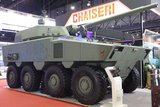Hanwha contracted to develop radar for South Korean missile defence
Plans for the Iron Dome were approved in June 2021 to protect against North Korean long-range artillery. (Photo: DAPA)
South Korea has taken another step towards developing its own version of Israel’s Iron Dome in an effort to protect itself, particularly the country’s capital Seoul, against missiles flying at low altitudes over short distances and artillery.
The country’s Hanwha Systems has received a contract valued at KRW131.5 billion (US$92 million) to develop the radar for the LAMD, a system described by the company as a “Korean-style Iron Dome”.
In a statement the company said: “The LAMD is designed to intercept large numbers of missiles flying at low altitudes and over short distances.
“Since it can respond to missiles approaching
Already have an account? Log in
Want to keep reading this article?
More from Land Warfare
-
![New agreement signed and another order for CV90s]()
New agreement signed and another order for CV90s
More than 1,800 BAE Systems Hägglunds CV90 armoured personnel carriers/infantry fighting vehicles have been ordered by European countries, with some looking at the platform as an option for a light tank.
-
![Next stage approved for major European robot programme]()
Next stage approved for major European robot programme
The European Commission and Milrem Robotics have signed a grant agreement for iMUGS2, following on from the original iMUGS collaboration to develop modular and scalable architecture for crewed and uncrewed systems.
-
![Germany set to order 75 more Leopard 2A8s after 12 months of wins for the platform]()
Germany set to order 75 more Leopard 2A8s after 12 months of wins for the platform
Leopard 2 variants have been introduced in 15 European countries and are in use across 23 nations worldwide, with 301 Leopard 2A8s alone having now been ordered.
-
Chaiseri’s quartet of new vehicles offers fresh capabilities to Asian markets
The Guardian-T 8x8, Hisaar MRAP 4x4, Ridgeback 4x4 and Jackal 4x4 were all on display at Defense & Security 2025, with target markets for the vehicles including Indonesia, Malaysia and the Philippines as well as Thailand.
-
![The British Army’s Land Mobility Programme – all change but no progress?]()
The British Army’s Land Mobility Programme – all change but no progress?
The UK’s Land Mobility Programme, an effort to replace thousands of British Army vehicles, may be about to undergo a radical change in direction.

























